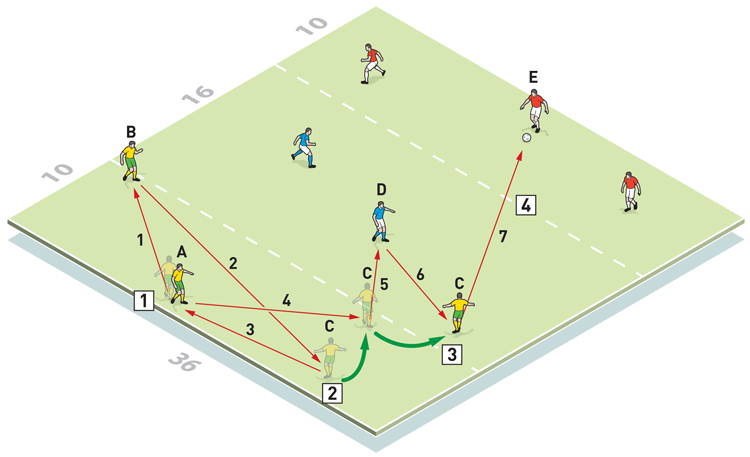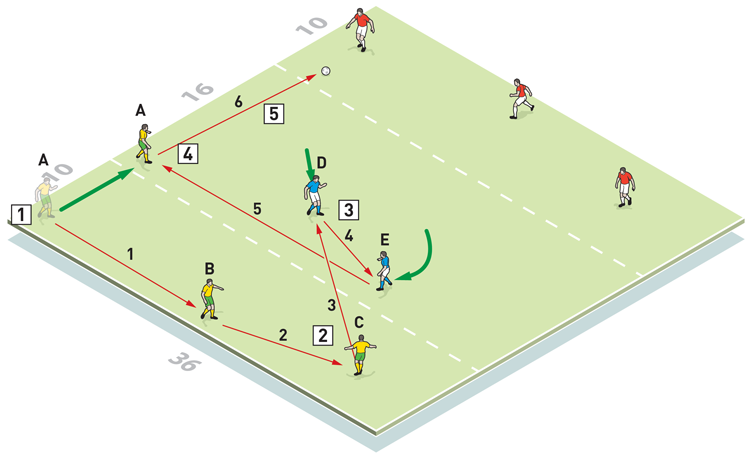Fast passing affecting change of play
This session looks at the benefits of quick passing and switches of play.

| Area | Up to 60x60 yards |
| Equipment | Balls, bibs, cones, goals, poles |
| No. of Players | Up to 20 |
| Session Time | Passing sequences 2x3mins each, Small-sided games 2x12mins each – for both, rotate players in between |
This session looks at the benefits of quick passing and switches of play.
At any level of football, the ability to move the ball around with pace and purpose is very important, and this session can work in many different ways. We can choose to run it in its entirety, or just take individual exercises, but whatever elements are used, it must be practised at a high tempo.
We’ll run it frequently. It’s great for reminding players of the consequences of match events, and the benefits of switching play from one flank to the other, whilst also giving them licence to play through midfield should they wish to. Ultimately, we want them to come out the other side with more time and space on the ball.
What do I get the players to do?
Fast passing – 7-pass sequence
In a 36x36-yard area, we set up as shown in the diagram (1). The early part of this session looks at designated passing routines that involve one- and two-touch play, receiving on the half-turn, coming to meet the ball and positive attacking elements.
Beginning two-touch, the ball begins centrally on the bottom touchline and a set passing pattern is constructed. Play is moved out to the flank before a long pass to the other end of the practice area. The sequence now repeats, coming back the other way.
1

2. B switches play to the right and C plays a one-two with A
3. C plays the ball to D and moves forward to collect a return pass
4. The move is completed with a long ball to E in the far zone. The move now comes back in the other direction
Fast passing – 6-pass sequence
In the same area, we construct a new passing move that now sees key elements of play develop through the middle (2). This again starts two-touch, with the intention of progressing to one-touch.
2

2. B switches the ball right to C who in turn feeds D
3. D comes to meet the pass and lays off to E
4. E passes wide to A who has advanced forward from left-back to meet the ball
5. A pass to F in the top area completes the move
What are the key things to look out for?
Players must look up, always ready to switch play with fast passing. Some have relatively stationary roles while others will need to come forward towards the ball – for instance, to mirror the requirements of a quick counter-attack.
Small-sided game – poles
To put practised passing elements into a game situation, we set up a game as shown (3). This is 8v8, plus four end players, and is played in a 60x50-yard area. Each goal is six yards wide. Teams would usually play 2-4-2 or 3-3-2, and can score by threading a pass through any of the three goals to a receiving team mate positioned on the other side. This means receiving players must move quickly behind the three pole goals, ensuring they are in position to receive a scoring pass. A goal can only be scored by an attacker inside the 10-yard end zone immediately in front of the goals.
3

Small-sided game – poles and fixed goal
Extending the playing area by 10 yards, we now replace the middle goals with fixed full-size goals (4). The role of one of the receiving players changes here because attackers now have one of two choices – lay a pass into the feet of a keeper in either of the wide goals, or score past the keeper in the middle goal.
4

What are the key things to look out for?
Players should always be looking for opportunities to switch play and find space on the flanks. When that space does present itself, it must be attacked quickly.
Again, movement to receive the ball and an awareness of other players is an essential part of this game. And fast passing and a high tempo is essential if players are to feel the full benefits of the session.
While a great routine for outfield players, the four receivers or keepers are also very active, since they have to move left and right in relation to the switching of the ball.
Editor's Picks
Attacking transitions
Deep runs in the final third
Using the goalkeeper in build-up play
Intensive boxes drill with goals
Penetrating the final third
Creating and finishing
My philosophy
Pressing initiation
Compact team movement
Coaches' Testimonials

Alan Pardew

Arsène Wenger

Brendan Rodgers

Carlos Carvalhal

José Mourinho

Jürgen Klopp

Pep Guardiola

Roy Hodgson

Sir Alex Ferguson

Steven Gerrard
Coaches' Testimonials

Gerald Kearney, Downtown Las Vegas Soccer Club

Paul Butler, Florida, USA

Rick Shields, Springboro, USA

Tony Green, Pierrefonds Titans, Quebec, Canada
Join the world's leading coaches and managers and discover for yourself one of the best kept secrets in coaching. No other training tool on the planet is written or read by the calibre of names you’ll find in Elite Soccer.
In a recent survey 92% of subscribers said Elite Soccer makes them more confident, 89% said it makes them a more effective coach and 91% said it makes them more inspired.
Get Monthly Inspiration
All the latest techniques and approaches
Since 2010 Elite Soccer has given subscribers exclusive insight into the training ground practices of the world’s best coaches. Published in partnership with the League Managers Association we have unparalleled access to the leading lights in the English leagues, as well as a host of international managers.
Elite Soccer exclusively features sessions written by the coaches themselves. There are no observed sessions and no sessions “in the style of”, just first-hand advice delivered direct to you from the coach.









